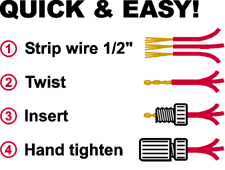DaleH
FOUNDER of Classic Parker Forum
Just got asked how I do this, as a CP poster wanted to use these

My opine is that they're ungainly at best, not 'streamlined' and would take a lot of heat shrink or goop to cover.
Here's what I do, say when I want to put 1 feed wire into 2 outputs. I cut a small 1" piece of dummy wire, and then size the butt connector so that "2" go in one end and then the "2" real wires into the other. Cover all with adhesive-lined heatshrink. Anything in the bilge gets 5200 forced into the ends of the butt connector after crimping, allowed to form up a bit (hour or so) and then dressed with the ad-HShrink.

My opine is that they're ungainly at best, not 'streamlined' and would take a lot of heat shrink or goop to cover.
Here's what I do, say when I want to put 1 feed wire into 2 outputs. I cut a small 1" piece of dummy wire, and then size the butt connector so that "2" go in one end and then the "2" real wires into the other. Cover all with adhesive-lined heatshrink. Anything in the bilge gets 5200 forced into the ends of the butt connector after crimping, allowed to form up a bit (hour or so) and then dressed with the ad-HShrink.




































